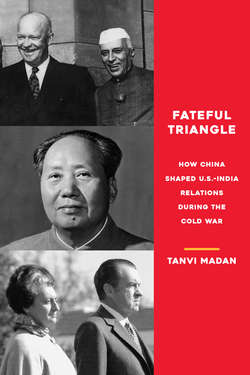Fateful Triangle

Реклама. ООО «ЛитРес», ИНН: 7719571260.
Оглавление
Tanvi Madan. Fateful Triangle
Acknowledgments
Introduction
1. The Orientation in the Orient (1949–1952)
China and India: The View from Washington (1947–1949)
China and the US: The View from Delhi (1947–1949)
Colliding Positions (1949–1952)
Red China or New China? Comparing Notes (1949–1950)
To Recognize or Not to Recognize
The Korean War: Seeing Each Other as Spoilers (1950)
Tibet: Lost by Default? (1950–1951)
Chinese Intervention in the Korean War: The Blame Game (1950–1951)
India as a Channel to China: Only Hurting Itself? (1951–1952)
What Have They Done for US Lately? (1951–1952)
2. Why So Wary? (1953–1956)
Interacting in the East (1953–1954)
Korea: Mediating Once More (1953–1954)
Indochina: Dueling Approaches (1953–1954)
Problematic Partnerships (1953–1955)
US-Pakistan: Collective Security or Creating Insecurity? (1953–1954)
Hindi-Chini Bhai-Bhai: Peaceful Coexistence or Naïve Nurturing? (1953–1955)
The Taiwan Strait Crisis (1954–1955)
The Problem of Prisoners: Major or Minor Issue? (1955–1956)
Other Problematic Partnerships (1955)
“Must Not Leave Backdoor Unlatched” (1950–1956)
3. The Pandit and the President (1956–1958)
Changing Diagnosis, Changing Prescription: The Infiltration of Ideas and Influence (1956–1958)
No More “You’re with Us or against Us”
The Development Race
Who Delivers Wins
The Glorious Gamble
Creeping Concern about China: The Infiltration of Ideas, Influence, and Individuals (1956–1958)
Changing Indian Perceptions
Contrasting Approaches
Mediating No More
Dealing with Differences
4. Semi-detached Ally? (1959–1962)
Ike Likes India; India Likes Ike (1959–1960)
From Hindi-Chini Bhai-Bhai to Zhou Enlai Hai-Hai (1959–1960)
Watching from Washington
The Soviet Stance
Pakistan’s Role
The Military Solution
The Camelot Years (1961–1962)
The “Present Excellent Trends”
Quid Pro Quo?
The Key to Asia
“Growls from Peking”
The China-Pakistan Relationship
Military Supply
“Indians to Arms”
The War and India’s Last Best Option: The US
The Tilt
5. Bread or Bombs (1963–1965)
The Limits and Possibilities of Alignment (November 1962–November 1963)
Debating Defense
Parley with Pakistan
The Substance of Alignment?
A Lost Opportunity?
Tethered, but Not Tied (December 1963–April 1965)
Guns or Butter
Diversification
Pakistan: Part of the Problem or Part of the Solution?
Mutual Disappointment (April–July 1965)
Vietnam: Dueling Approaches
Assets and Liabilities
The Stakes Made Evident (August–September 1965)
6. Playing It a Bit Cooler (1965–1968)
Dependence (Fall 1965–Spring 1966)
India: Too Big to Fail
The US: Too Important to Jettison
Disillusionment (Spring 1966–Spring 1967)
The Demands of Dependence
The Downside of Dependence
Vietnam: Force or Diplomacy?
Pakistan: Pressure or Persuasion?
Food Aid: With Strings or Chains?
Disengagement (Spring 1967–Winter 1968)
Losing Traction
Losing Interest
Reducing Dependence
The Soviet Option
The Look East Option
The Nuclear Option
The China Option?
7. Fluid New World (1969–1972)
Reaching for Rapprochements (1969)
US Views of China and India
India’s Views of China and the US
China, Keeping India Guessing (1970)
The US: Juggling China, India, and Pakistan (1970)
Triangulation and the Tilts (1971)
Early Reactions
The Indo-Soviet Treaty: The Insurance Policy
The Crisis and US-India Relations Deteriorate
A Vicious Circle (1972)
Reducing Dependence
The Plot for a Farce by Molière
8. Looking Both Ways (1973–1979)
Making Up (1973–1976)
Repairing Relations
Sino-US Relations and India (1973–1976)
Sino-Indian Relations and the US (1973–1976)
Dual Détentes (1974–1975)
The Carter-Desai Years (1977–1979)
A New Chapter
The China Rapprochements
Pluses and Minuses
On Various Visits
Complications
New Openings
Vietnam Once More
Rethinking Nonalignment
Alliances versus Diversification
Nonalignment Does Not Mean No Alignment
Diversification: Possibilities and Pitfalls
Ends, Ways, and Means
The Tangled Triangle
Notes. Introduction
Chapter 1
Chapter 2
Chapter 3
Chapter 4
Chapter 5
Chapter 6
Chapter 7
Chapter 8
Conclusion
Unpublished Primary Sources. Official Records
Manuscript Collections
Oral Histories
Recordings
Published Primary Sources. Documents
Newspapers and Periodicals
Autobiographies, Diaries, and Memoirs
Secondary Sources. Books
Articles and Book Chapters
Conference Papers
Websites and Online Resources
Отрывок из книги
FATEFUL TRIANGLE
How China Shaped U.S.-India Relations during the Cold War
.....
At the time that NSC-68 was being drafted, Europe remained the Truman administration’s primary area of focus. Policymakers accepted the potential loss of certain areas outside Europe—indeed Acheson said as much in his January speech. The Soviet Union remained the main threat; China was a secondary one. Fostering a Sino-Soviet split was still under consideration. But NSC-68 envisioned international communism rather than the Soviet Union as the threat, with no short-term possibility of “fragmentation.” Earlier reluctance to oppose a communist takeover of Taiwan (for fear that doing so would push China closer to the Soviet Union) was also revisited. A State Department reassessment of China policy in spring 1950 instead called for estimating the impact of such a takeover on perceptions of the global balance of power.
As John Lewis Gaddis has noted, NSC-68 might have had little impact had it not been for the Korean War. But the outbreak of the war, which eventually involved millions of soldiers and resulted in over 30,000 US combat deaths, “validate[d] several of NSC-68’s most important conclusions.”128 It also turned the spotlight on Asia, including China and India.
.....